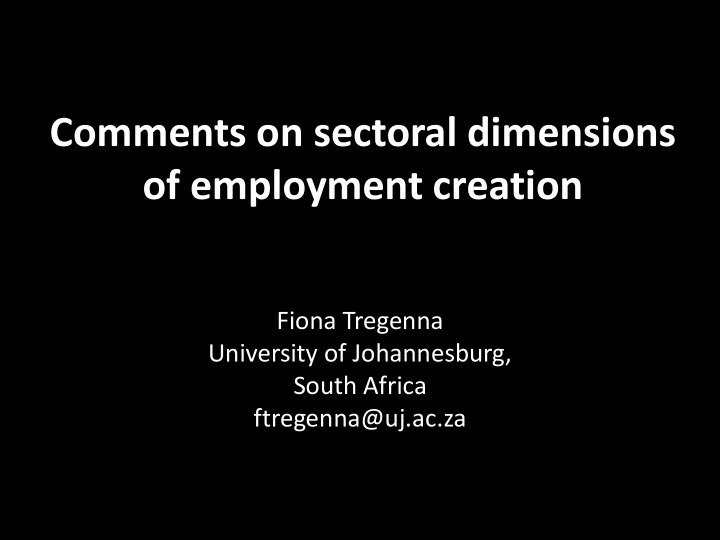

Comments on sectoral dimensions of employment creation Fiona Tregenna University of Johannesburg, South Africa ftregenna@uj.ac.za
Conceptualising and measuring employment- intensity at sectoral level Key importance: • Give policymakers the tools to target employment-intensive sectors • Projecting and monitoring employment impact of other policies Measures: • Employment / value added • Employment / capital stock • Employment multipliers Dynamic – employment elasticity of growth at sectoral level Various forecasting models, macroeconometric models etc.
Conceptualising and measuring employment-intensity Some considerations: • Further caveats in interpreting employment multipliers – imported intermediates – full- or part-time jobs – supply constraints – average not marginal – degree of disaggregation
Conceptualising and measuring employment-intensity Some considerations (cont.): • Relationship between employment-intensity and productivity – trade-off? • Beyond numbers, job quality… ‘decent work intensity’? • Other channels through which sectors can be important for employment.
Why a sectoral angle? • Recognition of the possibilities of structural imbalance [sectoral distribution of factors of production may well be sub-optimal for growth]. • Contrary to neo-classical assumptions of equilibrium and optimal distribution of factors of production based on equilibrating processes in marginal returns. • Structural imbalances may be particularly pronounced in developing countries . • Rationale for industrial policy.
Why a sectoral angle? • Sectoral structure neither growth-neutral nor employment-neutral • Sectoral differences in job quality – wage levels, benefits, job security, protection of labour rights, degree of unionisation etc. • Various other sectoral patterns of employment that could be relevant for policy in targeting sectors – differences in gender; age (youth); skills demand and development; vulnerability/volatility of employment; spatial patterns; etc.
Manufacturing sector • Kaldorian and Structuralist approaches – manufacturing has special role as engine of growth – stronger intersectoral linkages – greater scope for cumulative productivity increases – role in technological advancement – balance of payments • Inconclusive empirical evidence. • Employment – not the most labour-intensive but high linkages raise employment multipliers; high degree heterogeneity. • On average, greater proportion decent jobs in manufacturing? • Needs active policy to promote and sustain.
Sectoral linkages & employment multipliers • Calculated intersectoral linkages and employment multipliers, especially comparing manufacturing and services. • Exclude imported intermediates. • Overall, services sectors have stronger employment multipliers than manufacturing, but considerable heterogeneity. • Decline in employment multipliers over time. Tregenna (2008) ‘ The contributions of manufacturing and of services to employment creation and growth in South Africa’, South African Journal of Economics
Sectoral comparisons of employment intensity in SA • Comparison of subsectors by various measures of employment intensity • Top-ranked sectors by composite measure: Rank By employment multipliers By composite measure: 1 Other producers (services) Other producers (services) 2 Clothing Clothing 3 Catering & accommodation Catering & accommodation 4 Agriculture Textiles 5 Textiles Furniture Tregenna (2010) [also Venezuela case]
Deindustrialisation • International trend towards declining share of manufacturing in total employment. • New method for analysing changes in level and share of manufacturing employment. • In most ‘deindustrialisation’ episodes, decline in manufacturing employment is mostly accounted for by lower labour intensity [higher productivity]. Tregenna (2009) ‘ Characterising deindustrialisation: an analysis of changes in manufacturing employment and output internationally’, Cambridge Journal of Economics
Intersectoral outsourcing of employment • How much of sectoral shifts in employment is a ‘statistical illusion’ due to outsourcing? • New methodology for estimating intersectoral outsourcing. • Applied to specific labour-intensive occupations in South Africa. • Much of the apparent growth in private services employment accounted for by outsourcing from other sectors. • Has implications for understanding underlying trends in sectoral employment. Tregenna (2010) ‘How significant is the intersectoral outsourcing of employment in South Africa?’, Industrial and Corporate Change
Related issues in my own current research (not presented) • Relationship between sectoral structure and changes therein (including deindustrialisation) and growth – a cross- country econometric study • Relationship between sectoral structure and unemployment rates – a cross-country econometric study • International study of the intersectoral outsourcing of employment • Gendered patterns of employment changes during downturns, including sectoral dimensions
Some possible research issues (1) • Success stories of employment creation internationally – what lessons can be learnt with potential international applicability, especially re. sectoral aspects? • Sectoral patterns in employment changes during economic cycles especially crisis. • Reindustrialisation • Intersection between macro and industrial policy in sectoral policies. • Linking social dialogue and industrial policy in sectoral policies.
Some possible research issues (2) • Industrial policy tools for sectoral targeting, old & new. • Measuring ‘decent work intensity’ by sector. • Relationship between employment intensity & productivity. • Which subsectors of services have ‘desirable’ characteristics i.t.o. employment and growth?
Recommend
More recommend